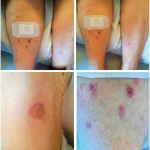 PHILADELPHIA—At ACR Convergence 2022, the much-anticipated ACR Review Course featured talks from eight experts. Topics reflected the heterogeneity of our field and included Sjögren’s disease, spondyloarthritis (SpA), osteoarthritis (OA), paraneoplastic rheumatic syndromes, metabolic bone disease, statin myopathy, Raynaud’s phenomenon and autoinflammatory syndrome. Here, I share highlights from this comprehensive, six-hour session.
PHILADELPHIA—At ACR Convergence 2022, the much-anticipated ACR Review Course featured talks from eight experts. Topics reflected the heterogeneity of our field and included Sjögren’s disease, spondyloarthritis (SpA), osteoarthritis (OA), paraneoplastic rheumatic syndromes, metabolic bone disease, statin myopathy, Raynaud’s phenomenon and autoinflammatory syndrome. Here, I share highlights from this comprehensive, six-hour session.
Sjögren’s Disease
Sara S. McCoy, MD, PhD, RhMSUS, associate professor, Department of Medicine, University of Wisconsin-Madison, kicked off the morning with a practical talk on Sjögren’s disease, which she said is now the preferred term, and the tools available for its diagnosis.
“Around one-third of the population will have dryness at some point in their life, so how do we determine when it’s Sjögren’s disease?” she queried the audience. “We take a good history and do a detailed rheumatologic exam as we would for any patient. We also include a detailed ocular and oral exam, salivary gland exam and neurologic exam,” she continued.
When it comes to history, Dr. McCoy noted that “we fortunately have a set of validated questions that can help us sort out when a patient potentially has Sjögren’s.” The most specific of these questions is, have you had recurrent or persistently swollen salivary glands (98% specificity, 36% sensitivity)?1
Dr. McCoy shared detailed, practical information on the ocular and oral exams in Sjögren’s. Pearls included the value of a bedside Schirmer’s test—she keeps the strips in her pocket and encouraged the audience to do the same—and parotid massage, which might express purulent fluid from Stensen’s duct, indicating infectious sialadenitis. To perform parotid massage, start at the angle of the mandible and move in a circular motion forward toward the ear and back around while visualizing Stensen’s duct inside the buccal mucosa.
As for diagnostic studies, Sjögren’s has no 100% definitive lab test.2 She explained, “Anti-SSA [anti-Sjögren’s-syndrome-related antigen A autoantibodies] is the most helpful with a prevalence of 60–80%. Anti-SSB [anti-Sjögren’s-syndrome-related antigen B autoantibodies] by itself isn’t as helpful, but dual-positive (anti-SSA and anti-SSB) patients tend to have more active disease with extraglandular involvement. I don’t recommend the use of ‘early Sjögren’s panels’ because studies have not proved them reliable.”
Interestingly, data show that salivary gland ultrasound (SGUS) may be substitutable for some of the ACR/EULAR Classification Criteria.3
“You can maintain the area under the curve if you replace any of the dryness measures with SGUS, but it doesn’t work quite as well as a substitute for anti-SSA or labial salivary gland biopsy,” Dr. McCoy noted.
Labial salivary gland biopsies are useful in the diagnosis of seronegative patients, identification of those at higher risk of lymphoma or extraglandular involvement (focus score >3), and differentiating Sjögren’s syndrome mimics.4 False positives are possible due to the variability in how biopsies are read. She advised, “It’s important to discuss with your pathologist how they’re doing the reads. Great resources online show how they should be doing them.”
Lastly, Dr. McCoy spoke to the usefulness of the ACR/EULAR Classification Criteria in clinical practice.5 “Because so many patients experience dryness at some point, you really need to show evidence of some kind of immune activation to diagnose Sjögren’s syndrome. Criteria don’t equal diagnosis, but they’re a great way to demonstrate immunologic involvement,” she said.
Spondyloarthritis
Jose U. Scher, MD, Steere-Abramson Associate Professor of Medicine, New York University Grossman School of Medicine, New York City, shared updates in SpA.
Dr. Scher first noted that the axial SpA spectrum is not linear. “Only about 10–25% of patients with non-radiographic axial SpA will progress to radiographic axial SpA in 10 years. Only about 20% of patients with radiographic sacroiliitis progress to syndesmophytes in four years. In general, the division between the two entities is arbitrary and becoming less clinically relevant. The burden of disease, treatment approach and clinical outcomes are similar.”6,7
Dr. Scher turned next to the updated 2022 Assessment of SpondyloArthritis International Society (ASAS)-EULAR Recommendations for the Management of Axial SpA.8 When it comes to the initiation of biologic or targeted synthetic disease-modifying anti-rheumatic drugs (b/tsDMARDs), the following are required: 1) a true diagnosis of axial SpA with objective evidence of inflammation (elevated C-reactive protein, positive magnetic resonance imaging of the sacroiliac joints or radiographic sacroiliitis); 2) true failure of non-steroidal anti-inflammatory drugs; and 3) objectively high disease burden as demonstrated by an Ankylosing Spondylitis Disease Activity Score of ≥2.1. Of note, options for initial b/tsDMARDs were expanded to include tumor necrosis factor inhibitors (TNFi), interleukin (IL) 17 inhibitors or Janus kinase inhibitors.
Dr. Scher also stressed the importance of reevaluating the diagnosis when the treatment fails. “If you treat someone with biologics and they don’t improve substantially, we should be rethinking the diagnosis in the first place,” he said.
Dr. Scher pivoted to share practical experience for psoriatic arthritis (PsA) treatments from the NYU Langone’s Psoriatic Arthritis Center, where work is in progress to publish more formal recommendations. In the presence of axial disease and mild to moderate skin involvement, TNFi or IL-17i are preferred; when skin involvement is more severe, infliximab is the center’s TNFi of choice.
For PsA patients without predominant axial disease (rather, peripheral arthritis, enthesitis or dactylitis), a three-month trial of methotrexate is considered. If methotrexate fails, there’s no specific agent for those with mild to moderate skin (which may include apremilast, TNFi, IL-17i or IL-23i). But in those with moderate to severe skin, IL-17i or IL-23i are preferred over TNFi (with or without combination methotrexate).
To conclude, Dr. Scher said, “Despite encouraging data with novel agents, there’s still a largely unmet need in PsA. While outcomes are demonstrably improved in the skin domain, we have considerable room for improvement when it comes to musculoskeletal outcomes.”
Metabolic Bone Disease
Bobo Tanner, MD, CCD, director, Osteoporosis Clinic, Division of Rheumatology, Vanderbilt University Medical Center, Nashville, Tenn., gave a whirlwind tour of the top 10 questions in osteoporosis. Highlights included how to discuss bisphosphonate side effects with our patients, how to address treatment failure and how to make treatment decisions according to life stages.
As most of you are aware, patients may be resistant to starting or continuing bisphosphonate therapy due to concerns about medication-related osteonecrosis of the jaw (MRONJ) and atypical femur fractures. Dr. Tanner shared a useful figure from the updated 2020 American Association of Clinical Endocrinologists/American College of Endocrinology Clinical Practice Guidelines for the Diagnosis and Treatment of Postmenopausal Osteoporosis that he often shows to patients in clinic.9 The risk of any fragility fracture or hip fracture in women ages 65 to 69 is a whopping 2,668 and 387 per 100,000 people per year, respectively. The risk of death by motor vehicle accident is 11, and death by murder 6 per 100,000 people per year. Compare these numbers to MRONJ, which has a risk of 0.7 per 100,000 people per year—just a smidge above the risk of death by lightning strike (0.6). Suddenly bisphosphonates don’t seem so bad, right?
When it comes to treatment failure in osteoporosis (defined by a significant decrease in bone mineral density [BMD] or recurrent fractures in a patient who is compliant with therapy), Dr. Tanner offered several pearls.9 “Remember, don’t set expectations that BMD is always going to go up. Stable or increasing BMD is a good response. Reviewing adherence to therapy and/or the accuracy of diagnosis are also crucial,” he said. In true treatment failure, therapy switch is necessary. Options include: 1) replacing a weaker anti-resorptive agent with a more potent drug in the same class, 2) replacing an oral drug with an injected drug to improve bioavailability, and 3) replacing a strong anti-resorptive with an anabolic agent.
Last, he drew our attention to the treatment approach developed by Felicia Cosman, MD, that considers what may be a 30 to 40 year lifespan with osteoporosis.10 For early postmenopausal women without fracture, hormonal therapies may be good options. For women in their late 60s and beyond without fracture, bisphosphonates may be used for three to five years. Then, a drug holiday (not drug retirement) should be monitored with BMD measurements and possibly bone turnover markers. In the case of women in their late 60s with major risk factors, denosumab is an additional option. And for women at any age with recent fracture, multiple fractures or very low BMD (e.g., T-score <-3.0), anabolic therapy should be considered first line.
Osteoarthritis
Carla R. Scanzello, MD, PhD, associate professor of medicine, Division of Rheumatology, University of Pennsylvania Perelman School of Medicine and the Corporal Michael J. Crescenz Veterans Affairs Medical Center, Philadelphia, discussed updates in OA. Highlights included the discordance between radiographic findings and the patient’s experience of pain, the importance of language choice when counseling patients, and intra-articular therapies.
Pain in OA is a complex phenomenon. Radiographic findings—commonly described as mild, moderate or severe—only show us the extent of joint damage in OA. Dr. Scanzello clarified, “These terms imply there’s some relationship between the patient’s experience of the severity of disease, and that’s really not the case.” Instead, she suggested that these findings might be better described as early, intermediate, advanced and end-stage.
“Further, many of our patients are developing pain sensitization (increased responsiveness of peripheral nociceptors). This lowers the threshold by which the pain-sensing neurons fire, increasing the sensation felt by the patient. This is associated with more severe pain with movement and is independent of radiographic severity,” she continued.11,12
Dr. Scanzello turned next to management, which “always starts with patient education.” She shared, “To me, patient education means that we manage expectations, but don’t needlessly discourage patients. We use the terms ‘wear and tear’ to describe OA, but if our goal is to get the patient moving and show them the benefit of exercise, this language is discouraging and confusing. Patients often think they are ‘wearing out’ their joint with normal daily activity like walking, which isn’t the case. Walking can be good for OA.”13 In essence, words matter.14
In addition, she noted that practitioners often give patients the impression that progression is par for the course, with joint replacement an inevitability. Dr. Scanzello clarified, “This isn’t necessarily true. Data show that the large majority of patients stay stable over several years. And, there are things the patient can do, like walk daily and manage weight, that can impact the progression rate.”13,15
Dr. Scanzello solidified her point with examples of vastly different messaging: “You can live a good life with OA” vs. “You have wear and tear arthritis and are going to need a knee replacement at some point.”16
Regarding intra-articular corticosteroid injections (ICS), Dr. Scanzello noted that “they’re probably effective at least in the short term, but sustained efficacy of repeated injections is still not clear. Still, ICS remain a reasonable option particularly in acute flares and in patients who aren’t candidates for joint replacement and see benefit with injections.”17 Prior trials showed an increase in cartilage thinning and increased risk of knee replacement with ICS, but a 2022 study showed no increased risk of radiographic progression or knee replacement when compared to patients who received viscosupplementation (hyaluronic acid derivatives), which is reassuring.18
Regarding viscosupplementation, a recent systematic review and meta-analysis showed that “in a nutshell, the minimum clinically important difference for efficacy in pain control was not met.” She added, “However, since the ACR recommendations against use are conditional, I still do use these agents for select patients that perceive benefit as the risk is low.”19
“My patients often ask about platelet-rich plasma, too. [Currently], there is no evidence that this works,” Dr. Scanzello concluded.20
Statin Myopathy
Lisa Christopher-Stine, MD, MPH, professor of medicine and neurology, Johns Hopkins University School of Medicine, Baltimore, gave an excellent talk on statin myopathy, both autoimmune and toxic. Highlights included high-yield tips to differentiate the two, statin rechallenge and options for patients who are truly statin intolerant.
In differentiating statin-associated autoimmune necrotizing myopathy (autoimmune myopathy) and self-limited, toxic statin myopathy (toxic myopathy), Dr. Christopher-Stine noted that statin duration is key. Those with autoimmune myopathy are exposed to statins an average of 36 months, whereas toxic myopathy occurs in days to weeks. “The 3-Hydroxy-3-Methylglutaryl-CoA Reductase (HMGCR) autoantibody has very high sensitivity and specificity, so in the right clinical setting, you can feel confident in a diagnosis of autoimmune myopathy when it’s positive,” she added. Further, toxic myopathy eventually dissipates after the statin is stopped. “If your creatine kinase is climbing after cessation, that’s a big clue that you’re dealing with autoimmune myopathy.” Last, Dr. Christopher-Stine added, “Dysphagia is never present in the toxic version, so this is a nice question to ask, too.”21
Two recent nocebo trials help inform the question of statin rechallenge in toxic myopathy. The nocebo effect describes a phenomenon whereby a negative outcome occurs because the inert substance is perceived to be harmful. In the SAMSON trial, the difference in symptom severity reported for placebo compared with statin therapy was not clinically significant. Ninety percent developed the same symptoms on placebo using random monthly crossover sequences over 12 months, and half of the participants successfully restarted statins.22 In the StatinWISE trial, no evidence of difference in muscle symptom scores was seen between statin and placebo periods in patients with previously documented statin intolerance.23
When it comes to statin rechallenge in patients with toxic myopathy, Dr. Christopher-Stine recommended, “Take away the statin and wait. See what happens. Then, assess whether you and the patient are comfortable rechallenging. Encourage the patient to keep a symptom diary after restarting therapy. To increase the likelihood of statin tolerance, one could try switching brands, lowering doses, every other day or three times weekly dosing, or a lower dose of a statin plus a non-statin.” Of note, the only absolute contraindication to statins when it comes to inflammatory myopathies is anti-HMGCR positivity. “Red yeast rice, which is chemically equivalent to lovastatin, should also be avoided in people with autoimmune myopathy,” Dr. Christopher-Stine noted.
So what if patients are truly statin intolerant? The American College of Cardiology released multi-society guidelines in October 2022 that offer helpful guidance on the use of non-statin therapies (approved since 2018) for primary and secondary prevention.24 First-line non-statin therapy includes ezetimibe or proprotein convertase subtilisin/kexin type 9 inhibitors like evolocumab and alirocumab. Bempedoic acid and inclisiran are second-line options. As rheumatologists trying to keep our patients healthy, we might consider referring to this guideline in consultation notes sent back to primary care providers.
Paraneoplastic Syndromes
Laura Cappelli, MD, MHS, assistant professor of medicine and oncology, Johns Hopkins University School of Medicine, Baltimore, discussed how to recognize rheumatic paraneoplastic conditions and how to screen for cancer in this context. Of note, her talk didn’t include classic autoimmune rheumatic diseases, such as myositis and systemic sclerosis (patients in whom we should always think about cancer screening with new onset disease).
Paraneoplastic rheumatic syndromes include a variety of musculoskeletal syndromes that are similar to rheumatic diseases.25-27 They are associated with malignancy but not caused directly by the tumor itself or metastases. They typically (but not always) improve with treatment of the underlying cancer. All have differing strengths of association with cancer, and evaluation for cancer is part of the initial evaluation in all of these patients.
Dr. Cappelli covered seven conditions, for which select clinical pearls are listed here. In descending order of relative cancer risk, these included:
- Palmar fasciitis and polyarthritis: About 80% of these patients have concomitant malignancy. It’s characterized by a “woody” fibrosis of the palms that leads to progressive flexion deformities of the fingers. It’s most frequently associated with ovarian cancer, so consider a pelvic ultrasound in addition to routine age/sex appropriate cancer screening in female patients.
- Remitting seronegative symmetrical synovitis with pitting edema (RS3PE): Sixteen to 30% of patients have concomitant malignancy. Dr. Cappelli noted, “In RS3PE, over 80% of patients have pitting edema of the hands. So if that’s not there, think hard about this diagnosis.”
- Hypertrophic osteoarthropathy: It occurs in 1% of all primary lung cancers, and lung cancer is the second most common cancer in the United States. The two distinctive signs are clubbing and periostitis. Chest imaging is key when this is suspected.
- Eosinophilic fasciitis: This is a fibrosing disorder of the fascia that’s more often idiopathic than neoplastic, but it can be associated with benign or malignant hematologic conditions in 10% of cases. “In addition to age/sex appropriate cancer screening, check a complete blood count with differential and ask about B-symptoms,” she advised.
- Pancreatic polyarthritis and panniculitis: This is a rare phenomenon that’s most commonly associated with acute pancreatitis, but 12% have pancreatic cancer. Patients have panniculitis that may look like erythema nodosum, symmetric polyarthritis that may mimic rheumatoid arthritis (RA), and elevated lipase levels with or without gastrointestinal symptoms.
- Erythromelalgia: This condition is characterized by attacks of warmth, pain and redness of the extremities and can be associated with hematologic malignancies less than 10% of the time.
- Leukocytoclastic vasculitis (LCV): Dr. Cappelli noted, “I’m including LCV just to keep the thought in your head that this can be paraneoplastic in a minority of cases (4%).”
To conclude, she stressed the importance of relative cancer risk, which tells us “how concerned we should be when a patient presents with one of these syndromes, how hard we should look and how hard we should recheck for cancer.”
Regarding screening tests, Dr. Cappelli counseled, “It depends on the patient—their age, sex, cancer risk factors and clinical history with a thorough review of systems. Age/sex-appropriate cancer screening comes next. Additional testing should consider the patient’s symptoms and known cancer types associated with a particular syndrome. Pre-test probability will lead you in the right direction in medicine generally, but this is particularly true with paraneoplastic syndromes.”
Raynaud’s Phenomenon
John D. Pauling, BMedSci, BMBS, PhD, FRCP, consultant rheumatologist, North Bristol NHS Trust and the Musculoskeletal Research Unit, University of Bristol, United Kingdom, provided an overview of the management of primary and secondary Raynaud’s phenomenon (RP) guided by pathophysiologic data. His discussion of primary RP and the treatment of systemic sclerosis-associated RP (SSc-RP) is highlighted here.
Primary RP, in which RP is not associated with a known condition, is common, occurring in about 10% of the general population.28 Dr. Pauling noted, “I think that what we’ve considered primary RP is a fairly simple homogeneous group, but it’s actually far more complex than we’ve given it credit for.” Understanding different physiologic contributors to primary RP can help position a patient and influence best management.
Primary RP may be an inherited functional vasospastic disorder, with heritability for RP reported as 55% to 64%.29 It also may be an appropriate thermoregulatory response to cold climates, as arteriovenous anastomoses of the digits are critically important to helping us maintain core temperature—especially in those who are underweight. Dr. Pauling explained, “There’s a relationship between body mass index (BMI) and the presence of RP.” In a study from The Netherlands, women with low BMI (<18.5 kg/m2) were three times as likely to have RP, and men nearly six times as likely. If BMI was greater than 30 kg/m2, it was protective against the development of RP.30
Subclinical atherosclerotic disease may also play a role. The risk of cardiovascular disease (CVD) is increased among people with primary RP (odds ratio 3.51; 95% confidence interval, 1.52–8.11; P=0.003), and people with digital blanching (but not cyanosis) have a 1.5-fold increased risk of CVD events.31
Last, cold intolerance also contributes. Studies have documented a distinct psychological phenotype of people with primary compared to secondary RP, and primary RP occurs in 18% to 53% of patients with fibromyalgia.32-33
Dr. Pauling suggested taking all components into account (physiologic thermoregulatory response, cold intolerance and subclinical atherosclerotic disease) when crafting a management approach.28 He elaborated, “Maintaining core temperature—not just the temperature of the fingers—is vital. Smoking cessation is vital, as well as optimizing cardiovascular risk factors.”
As for secondary RP, Dr. Pauling shared, “You don’t develop primary RP later in life. If you have a 55-year-old sitting in front of you with new symptoms, you need to ask yourself why is this patient here in front of me now? What has changed? There will usually be a secondary cause in such patients.”
Patients with SSc-RP are of particular interest given the severity of RP symptoms. Dr. Pauling explained, “In actual fact, if you question patients and give them a survey about which symptoms bother them the most on a daily basis, it’s RP that features as the highest disease-specific manifestation of SSc. SSc-RP causes pain, numbness, emotional distress, loss of hand function, social isolation, body image dissatisfaction and impaired health-related quality of life. And we still have a very poor evidence base when it comes to treatment.”34,35 However, experts have authored treatment recommendations for SSc-RP based on clinical experience that are valuable to those of us caring for these patients.36-38
Autoinflammatory Diseases
Dan Kastner, MD, PhD, NIH, distinguished investigator, National Human Genome Research Institute, Bethesda, Md., wrapped up the day with a detailed review of several autoinflammatory diseases (disorders of innate immunity). Pearls from this list of conditions are highlighted here.
He begun with the hereditary recurrent fevers, many of which are mediated by IL-1:39
- Familial Mediterranean fever (FMF): Erysipeloid erythema is a characteristic rash of FMF. It’s a reddish, raised painful rash that usually occurs on the ankle or dorsum of the foot. Canakinumab is now U.S. Food & Drug Administration (FDA) approved for treatment of FMF in patients intolerant of or unresponsive to colchicine (which is usually an effective treatment).
- TNF receptor-associated periodic syndrome (TRAPS): “TRAPS differs from FMF in that inheritance is autosomal dominant, attacks may last four to six weeks at a time (as opposed to one to three days for FMF), and it doesn’t respond to colchicine,” Dr. Kastner said. TNFi are no longer recommended for treatment, but canakinumab is FDA approved.
- Hyperimmunoglobulinemia D with periodic fever syndrome (HIDS): Also called mevalonate kinase deficiency, HIDS occurs in the first year of life and is characterized by three- to seven-day febrile episodes of abdominal pain, arthritis/arthralgia, diffuse maculopapular rash, prominent cervical adenopathy and/or aphthous ulcers.
- Cryopyrin-associated periodic syndromes (CAPS): CAPS is an umbrella term for familial cold autoinflammatory syndrome, Muckle-Wells syndrome and neonatal-onset multisystem inflammatory disease. All three are caused by mutations in the NLRP3 gene, which encodes the cryopyrin protein.
When it comes to treatment, colchicine is usually effective in FMF, but not in the other IL-1 hereditary recurrent fevers. Anakinra, canakinumab and rilonacept are each FDA approved for at least one of each of the above, and very effective. Dr. Kastner said, “These are diagnoses you want to make if you can because you can really make a difference in these patients’ lives.”
Dr. Kastner turned next to two recently discovered entities: deficiency of adenosine deaminase 2 (DADA2) and vacuoles, E1 ubiquitin-activating enzyme, X-linked, autoinflammatory somatic (VEXAS) syndrome:
- DADA2: A monogenic vasculitis syndrome characterized by fevers, vasculopathy (from livedo reticularis to polyarteritis nodosa), life-threatening ischemic and/or hemorrhagic strokes, cytopenias, hypogammaglobulinemia and/or hepatic and renal manifestations.40 TNFi therapy has a dramatic effect on the prevention of recurrent strokes in these patients. Dr. Kastner shared data from a National Institutes of Health cohort, noting that “15 kids had had 55 strokes over 2,077 patient-months of observation, and after TNFi initiation (733 patient-months), the number of strokes was 0.”41
- VEXAS: A monogenic disease of adulthood caused by somatic mutations in UBA1 in hematopoietic progenitor cells that is characterized by severe and diverse inflammatory and hematologic manifestations.42 Steroids are currently the mainstay of treatment, but Dr. Kastner postulated that hematopoietic stem cell transplant might be the definitive treatment in the future.
In Sum
As always, this year’s ACR Review Course didn’t disappoint. Whether you’re studying for the boards or just trying to stay up to date on some less common rheumatic pathology, the ACR Review Course has something for you.
Samantha C. Shapiro, MD, is the executive editor of Harrison’s Principles of Internal Medicine. As a clinician educator, she practices telerheumatology and writes for both medical and lay audiences.
References
- Vitali C, Moutsopoulos HM, Bombardieri S. The European Community Study Group on diagnostic criteria for Sjögren’s syndrome. Sensitivity and specificity of tests for ocular and oral involvement in Sjögren’s syndrome. Ann Rheum Dis. 1994 Oct;53(10):637–647.
- Patel R, Shahane A. The epidemiology of Sjögren’s syndrome. Clin Epidemiol. 2014 Jul 30;6(1):247–55.
- van Nimwegen JF, Mossel E, Delli K, et al. Incorporation of salivary gland ultrasonography into the American College of Rheumatology/European League Against Rheumatism criteria for primary Sjögren’s syndrome. Arthritis Care Res (Hoboken). 2020;72(4):583–590.
- Risselada AP, Kruize AA, Goldschmeding R, et al. The prognostic value of routinely performed minor salivary gland assessments in primary Sjögren’s syndrome. Ann Rheum Dis. 2014 Aug;73(8):1537–1540.
- Shiboski CH, Shiboski SC, Seror R, et al. 2016 American College of Rheumatology/European League Against Rheumatism classification criteria for primary Sjögren’s syndrome: A consensus and data-driven methodology involving three international patient cohorts. Arthritis Rheumatol. 2017 Jan;69(1):35–45.
- Hebeisen M, Micheroli R, Scherer A, et al. Spinal radiographic progression in axial spondyloarthritis and the impact of classification as nonradiographic versus radiographic disease: Data from the Swiss Clinical Quality Management cohort. PLoS One. 2020 Mar 20;15(3):e0230268.
- Protopopov M, Poddubnyy D. Radiographic progression in non-radiographic axial spondyloarthritis. Expert Rev Clin Immunol. 2018 Jun;14(6):525–533.
- Ramiro S, Nikiphorou E, Sepriano A, et al. ASAS-EULAR recommendations for the management of axial spondyloarthritis: 2022 update. Ann Rheum Dis. 2022 Oct 21;ard-2022-223296. Online ahead of print.
- Camacho PM, Petak SM, Binkley N, et al. American Association of Clinical Endocrinologists/American College of Endocrinology clinical practice guidelines for the diagnosis and treatment of postmenopausal osteoporosis – 2020 update. Endocr Pract. 2020 May;26(Suppl 1):1–46.
- Cosman F. Long-term treatment strategies for postmenopausal osteoporosis. Curr Opin Rheumatol. 2018 Jul;30(4):420–426.
- Arendt-Nielsen L, Nie H, Laursen MB, et al. Sensitization in patients with painful knee osteoarthritis. Pain. 2010 Jun;149(3):573–581.
- Neogi T, Guermazi A, Roemer F, et al. Association of joint inflammation with pain sensitization in knee osteoarthritis: The Multicenter Osteoarthritis Study. Arthritis Rheumatol. 2016 Mar;68(3):654–661.
- Master H, Thoma LM, Neogi T, et al. Daily walking and the risk of knee replacement over 5 years among adults with advanced knee osteoarthritis in the United States. Arch Phys Med Rehabil. 2021 Oct;102(10):1888–1894.
- Stewart M, Loftus S. Sticks and stones: The impact of language in musculoskeletal rehabilitation. J Orthop Sports Phys Ther. 2018 July;48(7):519–522.
- Joseph GB, McCulloch CE, Nevitt MC, et al. Effects of weight change on knee and hip radiographic measurements and pain over 4 years: Data from the Osteoarthritis Initiative. Arthritis Care Res (Hoboken). 2022 Mar 4;10.1002/acr.24875. Online ahead of print.
- Skou ST, Roos EM. Good life with osteoarthritis in Denmark (GLA:D): Evidence-based education and supervised neuromuscular exercise delivered by certified physiotherapists nationwide. BMC Musculoskelet Disord. 2017 Feb 7;18(1):72.
- Najm A, Alunno A, Gwinnutt JM, et al. Efficacy of intra-articular corticosteroid injections in knee osteoarthritis: A systematic review and meta-analysis of randomized controlled trials. Joint Bone Spine. 2021 Jul;88(4):105198.
- Bucci J, Chen X, LaValley M, et al. Progression of knee osteoarthritis with use of intraarticular glucocorticoids versus hyaluronic acid. Arthritis Rheumatol. 2022 Feb;74(2):223–226.
- Pereira TV, Jüni P, Saadat P, et al. Viscosupplementation for knee osteoarthritis: Systematic review and meta-analysis. BMJ. 2022 Jul 6;378:e069722.
- Bennell KL, Paterson KL, Metcalf BR, et al. Effect of intra-articular platelet-rich plasma vs placebo injection on pain and medial tibial cartilage volume in patients with knee osteoarthritis: The RESTORE Randomized Clinical Trial. JAMA. 2021 Nov 23;326(20):2021–2030.
- Christopher-Stine L, Basharat P. Statin-associated immune-mediated myopathy: Biology and clinical implications. Curr Opin Lipidol. 2017 Apr;28(2):186–192.
- Wood FA, Howard JP, Finegold JA, et al. N-of-1 trial of a statin, placebo, or no treatment to assess side effects. N Engl J Med. 2020 Nov 26;383(22):2182-2184.
- Herrett E, Williamson E, Beaumont D, et al. Study protocol for statin web-based investigation of side effects (StatinWISE): A series of randomised controlled N-of-1 trials comparing atorvastatin and placebo in UK primary care. BMJ Open. 2017 Dec 1;7(12):e016604.
- Lloyd-Jones DM, Morris PB, Ballantyne CM, et al. 2022 ACC expert consensus decision pathway on the role of nonstatin therapies for LDL-cholesterol lowering in the management of atherosclerotic cardiovascular disease risk: A report of the American College of Cardiology Solution Set Oversight Committee. J Am Coll Cardiol. 2022 Oct 4;80(14):1366–1418.
- Manger B, Schett G. Paraneoplastic syndromes in rheumatology. Nat Rev Rheumatol. 2014 Nov;10(11):662–670.
- Cappelli LC, Shah AA. The relationships between cancer and autoimmune rheumatic diseases. Best Pract Res Clin Rheumatol. 2020 Feb;34(1):101472.
- Khan F, Kleppel H, Meara A. Paraneoplastic musculoskeletal syndromes. Rheum Dis Clin North Am. 2020 Aug;46(3):577–586.
- Pauling JD, Hughes M, Pope JE. Raynaud’s phenomenon—an update on diagnosis, classification and management. Clin Rheumatol. 2019 Dec;38(12):3317–3330.
- Hur YM, Chae JH, Chung KW, et al. Feeling of cold hands and feet is a highly heritable phenotype. Twin Res Hum Genet. 2012 Apr;15(2):166–169.
- Abdulle AE, Brouwer E, Goor HV, et al. THU0330 Prevalence of Renaud’s phenomenon in the northern parts of The Netherlands: An epidemiological study of the Lifelines Cohort. Ann Rheum Dis. 2019 Jun;78(Suppl 2):445.
- Garner R, Kumari R, Lanyon P, et al. Prevalence, risk factors and associations of primary Raynaud’s phenomenon: Systematic review and meta-analysis of observational studies. BMJ Open. 2015 Mar;5(3):e006389.
- Wolfe F, Petri M, Alarcón GS, et al. Fibromyalgia, systemic lupus erythematosus (SLE), and evaluation of SLE activity. J Rheumatol. 2009 Jan;36(1):82–88.
- Bayle O, Consoli SM, Baudin M, et al. Idiopathic and secondary Raynaud’s phenomenon. Comparative psychosomatic approach. Presse Med. 1990 Apr 21;19(16):741–745.
- Pauling JD, Reilly E, Smith T, Frech TM. Evolving symptom characteristics of Raynaud’s phenomenon in systemic sclerosis and their association with physician and patient-reported assessments of disease severity. Arthritis Care Res (Hoboken). 2019 Aug;71(8):1119–1126.
- Khouri C, Lepelley M, Bailly S, et al. Comparative efficacy and safety of treatments for secondary Raynaud’s phenomenon: A systematic review and network meta-analysis of randomised trials. Lancet Rheumatol. 2019 Dec 1;1(4):E237–E246.
- Hughes M, Ong VH, Anderson ME, et al. Consensus best practice pathway of the UK Scleroderma Study Group: Digital vasculopathy in systemic sclerosis. Rheumatology (Oxford). 2015 Nov;54(11):2015–2024.
- Fernández-Codina A, Walker KM, Pope JE. Treatment algorithms for systemic sclerosis according to experts. Arthritis Rheumatol. 2018 Nov;70(11):1820–1828.
- Kowal-Bielecka O, Fransen J, Avouac J, et al. Update of EULAR recommendations for the treatment of systemic sclerosis. Ann Rheum Dis. 2017 Aug;76(8):1327–1339.
- Romano M, Arici ZS, Piskin D, et al. The 2021 EULAR/American College of Rheumatology points to consider for diagnosis, management and monitoring of the interleukin-1 mediated autoinflammatory diseases: Cryopyrin-associated periodic syndromes, tumour necrosis factor receptor-associated periodic syndrome, mevalonate kinase deficiency, and deficiency of the interleukin-1 receptor antagonist. Ann Rheum Dis. 2022 Jul;81(7):907–921.
- Meyts I, Aksentijevich I. Deficiency of adenosine deaminase 2 (DADA2): Updates on the phenotype, genetics, pathogenesis, and treatment. J Clin Immunol. 2018 Jul;38(5):569–578.
- Ombrello AK, Qin J, Hoffmann PM, et al. Treatment strategies for deficiency of adenosine deaminase 2. N Engl J Med. 2019 Apr 18;380(16):1582–1584.
- Grayson PC, Patel BA, Young NS. VEXAS syndrome. Blood. 2021 Jul 1;137(26):3591–3594.









